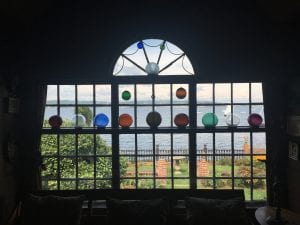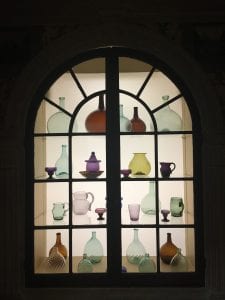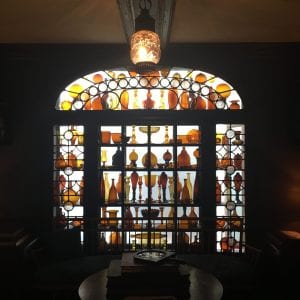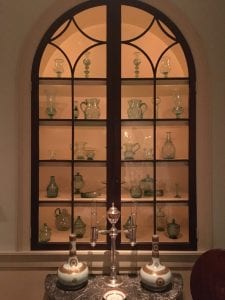The Display of Glass: Connections between Collectors
By Brooke Baerman, WPAMC Class of 2019
Beauport, or the Sleeper-McCann House, is a 1907 mansion overlooking the rocky harbor of Gloucester, Massachusetts. A visitor there will immediately notice that every room is a complete display in itself, containing collections arranged with such finesse that the individual objects become a part of a larger visual experience. This was the intention of Henry Davis Sleeper, one of America’s first interior designers, who carefully and thoughtfully planned each room in Beauport.
As the WPAMC Class of 2019 toured Beauport on our Northern trip, many of us saw a striking similarity between the interior designs of Beauport and Winterthur. The similarity is no coincidence: du Pont frequently consulted Sleeper on everything from the installation of electrical outlets to the display of furniture. Nowhere is Sleeper’s eye for delicate detail more apparent than in his displays of glass, and in the displays of glass at Winterthur.

These glass orbs at Beauport reflect the light and change throughout the day and year, depending on the sunlight and weather, creating many different visual effects, all of which are derived from their careful placement in a well-lit window. Image courtesy of Beauport/Historic New England, taken by the author.
The color, the light, the luminosity: no quality of glass is lost, because Sleeper has crafted and carefully lit his displays. Streams of sun enter rooms from all directions and make the transparent surfaces gleam.

At Winterthur, many glass bottles seem to glow from the artificial light that is as conscientiously placed as the windows in Beauport. Image courtesy of Winterthur Museum.
Arrangements of glass at Winterthur have followed Sleeper’s methods in this respect. A small closet of glass on the eighth floor, rarely seen by the public, is lit from behind. While Sleeper made every effort to use natural light, and Winterthur’s glass is artificially lit, the use of backlighting in this display still provides an homage to Sleeper.

A display of amber glass at Beauport is highlighted, quite literally, but sunlight streaming in through an opaque window. The space, from the fretwork to the light to the objects, has been curated to provide a pleasing viewing experience. Image courtesy of Beauport/Historic New England.
At Beauport, many pieces of glass are often clustered in monochromatic displays. Rare forms are juxtaposed with common bottles to emphasize a cohesive whole that values color above all else. Du Pont, like Sleeper, created rooms devoted to a single shade. One display of green glass on the sixth floor of Winterthur has a similar aesthetic to the many single-colored displays at Beauport, further cementing the aesthetic relationship between the two collectors.

This display of green glass on Winterthur’s sixth floor demonstrates Sleeper’s frequent use of the monochromatic arrangement of rooms and objects. Image courtesy of Winterthur Museum.
Sleeper’s approach to the display of collections, and to the display of glass in particular, exemplifies the Colonial Revival values that du Pont demonstrated at Winterthur. Sleeper and du Pont treasured the beauty of a space filled with cohesive objects, and they each believed that a room could evoke the imagined mood of an era. Even today, when their rooms tell us more about the early twentieth century than they do about the eighteenth, visitors can understand the effectiveness of these decorative techniques in creating a feeling of the past that is affecting, though inaccurate.
Moreover, the glass at Beauport and Winterthur demonstrates a vital fact of collecting and display: like the creation of an artwork, the creation and display of a collection does not occur in isolation. Instead, it is the result of many conversations, like those of Sleeper and du Pont, and many viewpoints, rather than the sole vision of a collector.
Sometimes, when visiting or studying at Winterthur, it feels as if I’m immersed in the singular vision of Henry Francis du Pont. Beauport reminded me that Winterthur is, in fact, the culmination of many dealers, collectors, and friends, all of whom left their mark on the beautiful rooms of the museum, an effect that can be seen in the reflection of glass.

Leave a Reply